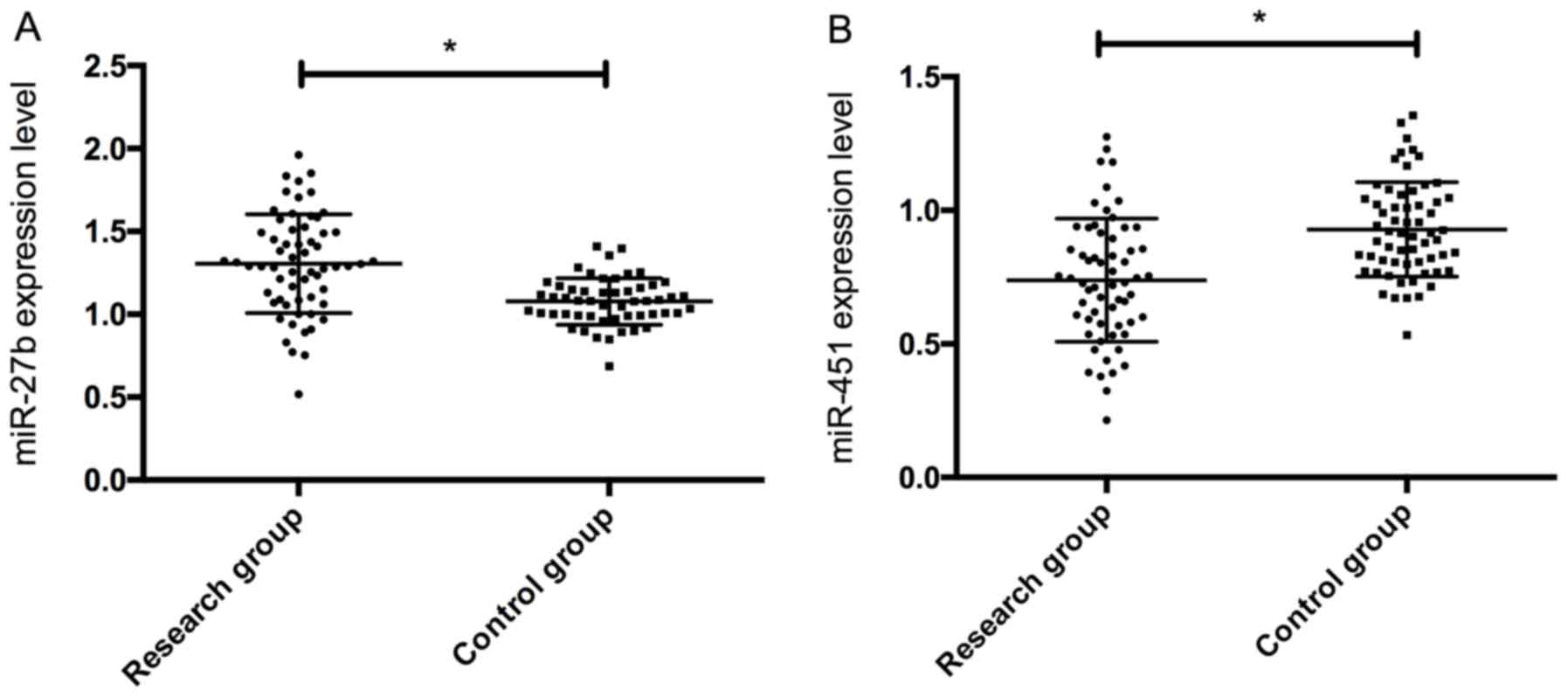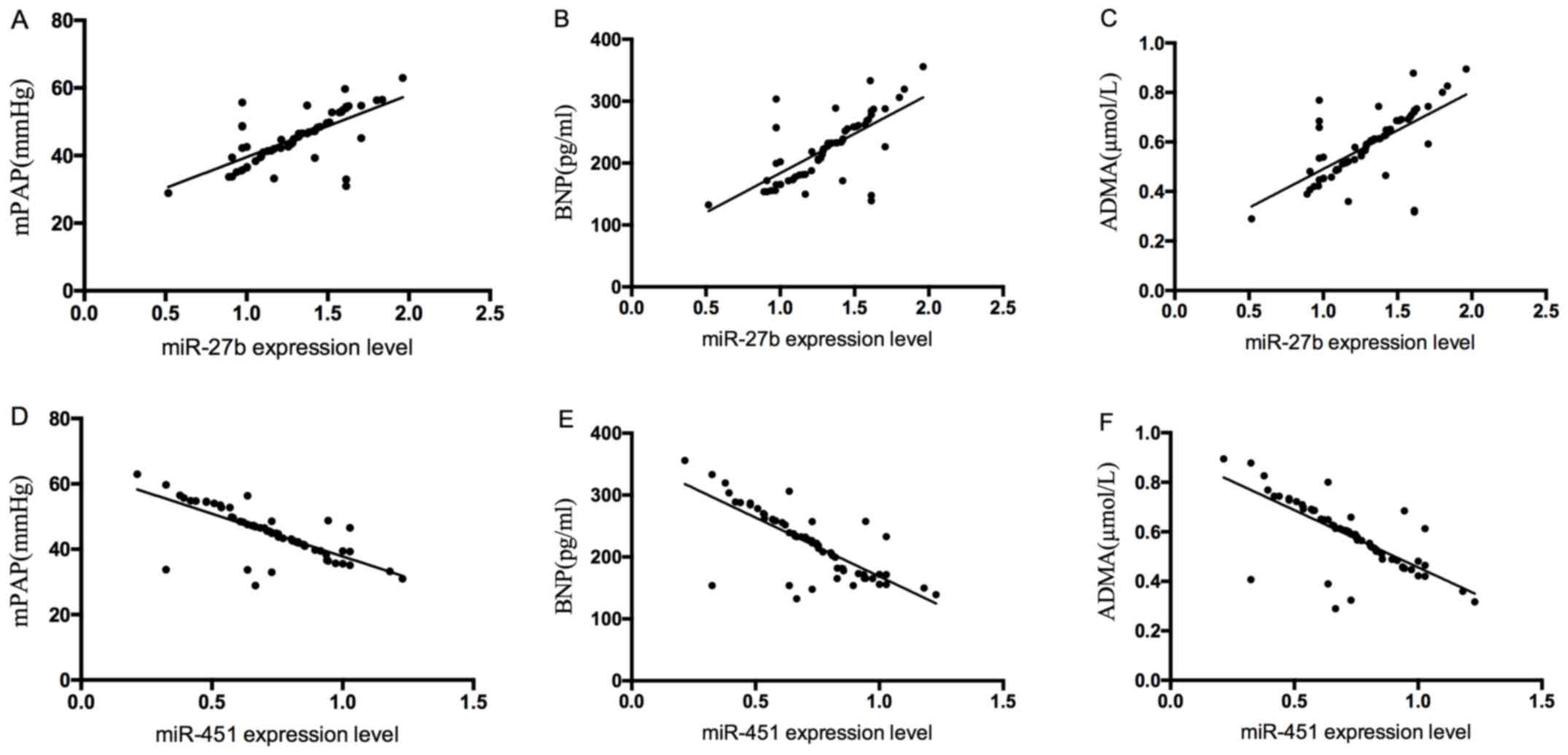|
1
|
Chew JD, Loyd JE and Austin ED: The
genetics of pulmonary arterial hypertension. Semin Respir Crit Care
Med. 38:585–595. 2017.PubMed/NCBI View Article : Google Scholar
|
|
2
|
van der Feen DE, Bartelds B, de Boer RA
and Berger RM: Pulmonary arterial hypertension in congenital heart
disease: Translational opportunities to study the reversibility of
pulmonary vascular disease. Eur Heart J. 38:2034–2041.
2017.PubMed/NCBI View Article : Google Scholar
|
|
3
|
Roberts KE, McElroy JJ, Wong WP, Yen E,
Widlitz A, Barst RJ, Knowles JA and Morse JH: BMPR2 mutations in
pulmonary arterial hypertension with congenital heart disease. Eur
Respir J. 24:371–374. 2004.PubMed/NCBI View Article : Google Scholar
|
|
4
|
Sun ML, Cheng CY, Wu DC, Zhao QH, Liu QQ,
Jiang R, Jiang X and Jing ZC: Long-term survival of patients with
repaired congenital heart disease associated pulmonary arterial
hypertension (CHD-PAH) in the modern management era. Eur Heart J.
34 (Suppl 1)(P287)2013.
|
|
5
|
Sun ML, Cheng CY, Wu DC, Zhang R, Zhang X,
Xu XQ, Sun K, Zhao QH, Wang X-J, Jiang R, et al: Survival of
patients with repaired CHD-PAH in the modern management era. J Am
Coll Cardiol. 63(A1484)2014.
|
|
6
|
Boucherat O, Potus F and Bonnet S:
microRNA and pulmonary hypertension. Adv Exp Med Biol. 888:237–252.
2015.PubMed/NCBI View Article : Google Scholar
|
|
7
|
Grant JS: The role of microRNA in the
development of pulmonary arterial hypertension: Studies in cell
culture and animal models. University of Glasgow, p263, 2014.
|
|
8
|
Hailong D and Yin XL: GW25-e2158. The
changes of plasma miR-18a, miR-27b, miR-130a, miR-204 in patients
with pulmonary arterial hypertension due to congenital heart
disease. J Am Coll Cardiol. 64 (Suppl 16):C190. 2014.
|
|
9
|
Caruso P, Dempsie Y, Stevens HC, McDonald
RA, Long L, Lu R, White K, Mair KM, McClure JD, Southwood M, et al:
A role for miR-145 in pulmonary arterial hypertension: Evidence
from mouse models and patient samples. Circ Res. 111:290–300.
2012.PubMed/NCBI View Article : Google Scholar
|
|
10
|
Wang X, Zhu H, Zhang X, Liu Y, Chen J,
Medvedovic M, Li H, Weiss MJ, Ren X and Fan GC: Loss of the
miR-144/451 cluster impairs ischaemic preconditioning-mediated
cardioprotection by targeting Rac-1. Cardiovasc Res. 94:379–390.
2012.PubMed/NCBI View Article : Google Scholar
|
|
11
|
Grymuza M, Małaczyńska-Rajpold K,
Jankiewicz S, Siniawski A, Grygier M, Mitkowski P, Kałużna-Oleksy
M, Lesiak M, Mularek-Kubzdela T and Araszkiewicz A: Right heart
catheterization procedures in patients with suspicion of pulmonary
hypertension - experiences of a tertiary center. Postepy Kardiol
Interwencyjnej. 13:295–301. 2017.PubMed/NCBI View Article : Google Scholar
|
|
12
|
Stephan R, Ghofrani H, Beghetti M, Ivy D,
Fritsch A, Weimann G, Saleh S, Apitz C and Frey R: Riociguat for
pulmonary arterial hypertension (PAH) associated with congenital
heart disease (CHD): A subgroup analysis from the PATENT studies.
BMC Pharmacol Toxicol. 16 (Suppl 1)(A79)2015.PubMed/NCBI View Article : Google Scholar
|
|
13
|
Chen IC and Dai ZK: Insight into pulmonary
arterial hypertension associated with congenital heart disease
(PAH-CHD): Classification and pharmacological management from a
pediatric cardiological point of view. Acta Cardiol Sin.
31:507–515. 2015.PubMed/NCBI View Article : Google Scholar
|
|
14
|
Chen W and Li S: Circulating microRNA as a
novel biomarker for pulmonary arterial hypertension due to
congenital heart disease. Pediatr Cardiol. 38:86–94.
2017.PubMed/NCBI View Article : Google Scholar
|
|
15
|
Zhao H, Guo Y, Sun Y, Zhang N and Wang X:
miR-181a/b-5p ameliorates inflammatory response in
monocrotaline-induced pulmonary arterial hypertension by targeting
endocan. J Cell Physiol. 235:4422–4433. 2020.PubMed/NCBI View Article : Google Scholar
|
|
16
|
Thum T, Galuppo P, Wolf C, Fiedler J,
Kneitz S, van Laake LW, Doevendans PA, Mummery CL, Borlak J,
Haverich A, et al: MicroRNAs in the human heart: A clue to fetal
gene reprogramming in heart failure. Circulation. 116:258–267.
2007.PubMed/NCBI View Article : Google Scholar
|
|
17
|
Grant JS, Morecroft I, Dempsie Y, van
Rooij E, MacLean MR and Baker AH: Transient but not genetic loss of
miR-451 is protective in the development of pulmonary arterial
hypertension. Pulm Circ. 3:840–850. 2013.PubMed/NCBI View
Article : Google Scholar
|
|
18
|
Ma K, Zhao Q, Chen W, Zhang H, Li S, Pan X
and Chen Q: Human lung microRNA profiling in pulmonary arterial
hypertension secondary to congenital heart defect. Pediatr
Pulmonol. 50:1214–1223. 2015.PubMed/NCBI View Article : Google Scholar
|
|
19
|
Wei C, Henderson H, Spradley C, Li L, Kim
IK, Kumar S, Hong N, Arroliga AC and Gupta S: Circulating miRNAs as
potential marker for pulmonary hypertension. PLoS One.
8(e64396)2013.PubMed/NCBI View Article : Google Scholar
|
|
20
|
McLellan J, Heneghan CJ, Perera R,
Clements AM, Glasziou PP, Kearley KE, Pidduck N, Roberts NW, Tyndel
S, Wright FL, et al: B-type natriuretic peptide-guided treatment
for heart failure. Cochrane Database Syst Rev: Dec 22, 2016 (Epub
ahead of print). doi: 10.1002/14651858.CD008966.pub2.
|
|
21
|
Pruneda-Alvarez LG, Ruíz-Vera T,
Ochoa-Martínez AC, Pérez-Vázquez FJ, González Palomo AK,
Ilizaliturri-Hernández CA and Pérez-Maldonado IN: Plasma asymmetric
dimethylarginine (ADMA) levels in Mexican women exposed to
polycyclic aromatic hydrocarbons (PAHs): A preliminary study. Sci
Total Environ. 572:1195–1202. 2016.PubMed/NCBI View Article : Google Scholar
|
|
22
|
Krowka MJ, Plevak DJ, Findlay JY, Rosen
CB, Wiesner RH and Krom RA: Pulmonary hemodynamics and
perioperative cardiopulmonary-related mortality in patients with
portopulmonary hypertension undergoing liver transplantation. Liver
Transpl. 6:443–450. 2000.PubMed/NCBI View Article : Google Scholar
|
|
23
|
Sr GY: Evaluation of acute hemodymamic
effect of inhaled iloprost in pulmonary artery hypertension with
right heart catheterization. Cardiovasc Revasc Med. 10:197.
2009.
|
|
24
|
Song XW, Zou LL, Cui L, Li SH, Qin YW,
Zhao XX and Jing Q: Plasma miR-451 echocardiography can be used as
a reference for the diagnosis of pulmonary hypertension. Acta
Pharmacol Sin. 39:1208–1216. 2018.PubMed/NCBI View Article : Google Scholar
|
|
25
|
Friedman WF: Proceedings of the National
Heart, Lung, and Blood Institute Pediatric Cardiology Workshop:
Pulmonary Hypertension. Pediatr Res. 20:811–824. 1986.PubMed/NCBI View Article : Google Scholar
|
|
26
|
Schuijt MT, Blok IM, Zwinderman AH, van
Riel AC, Schuuring MJ, de Winter RJ, Duijnhouwer AL, van Dijk AP,
Mulder BJ and Bouma BJ: Mortality in pulmonary arterial
hypertension due to congenital heart disease: Serial changes
improve prognostication. Int J Cardiol. 243:449–453.
2017.PubMed/NCBI View Article : Google Scholar
|


















